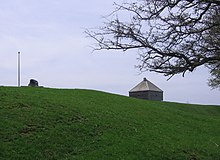Blokhauz
Blokhauz lub blokhaus (niem. Blockhaus; Block „blokada”; Haus „dom”) – niewielka wojskowa, ufortyfikowana budowla pełniąca funkcję schronu bojowego ze strzelnicami, służąca jako ostateczny punkt oporu[1].
Budowano go m.in. wewnątrz redut i lunet[1]. Stosowany był do ochrony mostów, tuneli, przejść i innych ważnych punktów strategicznych. Samodzielne blokhauzy były również wykorzystywane w terenach słabo zaludnionych, szczególnie w czasie wojen kolonialnych.
Przypisy
- ↑ a b Bochenek 1989 ↓, s. 24.
Bibliografia
- Witold Szolginia: Architektura. Warszawa: Sigma NOT, 1992, s. 26. ISBN 83-85001-89-1.
- Marian Laprus [red.]: Leksykon wiedzy wojskowej. Warszawa: Wydawnictwo Ministerstwa Obrony Narodowej, 1979, s. 45. ISBN 83-11-06229-3.
- Ryszard Henryk Bochenek: 1000 słów o inżynierii i fortyfikacjach. Warszawa: Wydawnictwo Ministra Obrony Narodowej, 1989. ISBN 83-11-07423-2.
Media użyte na tej stronie
Autor: Danie van der Merwe from Cape Town, South Africa, Licencja: CC BY 2.0
These Blockhouses were built in 1901 during the Anglo-Boer War. They were built by the British to protect the railway bridges from Boer attacks. The stone is local while the remaining materials were imported from Britain. These Blockhouses could house 20 men with water, ammunition and supplies stored on the lower floor. The "living" area was the middle floor and was accessible by a retractable ladder and the top floor was the "look-out" deck. Only 1000 of these Blockhouses were built and few have survived. They were very effective barriers and few saw any action.
(Requires Google Earth)(c) Verne Equinox z angielskojęzycznej Wikipedii, CC-BY-SA-3.0
Photo of Fort Edward (Nova Scotia) taken May 2006.
Autor: Radomil talk, Licencja: CC-BY-SA-3.0
Old Fort Colomb in Poznań





